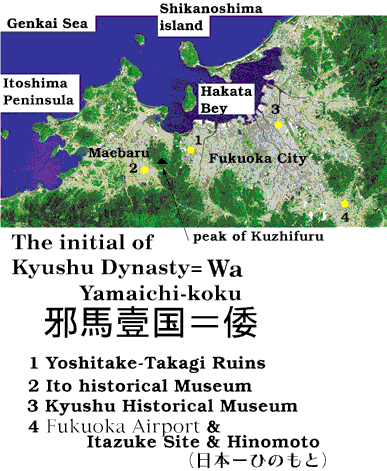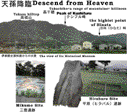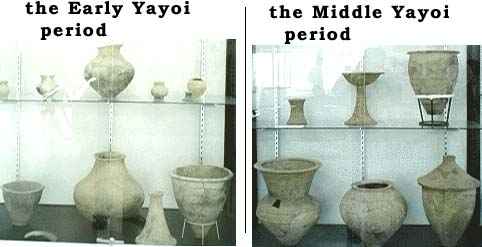
| Which place is it? |  |
|---|---|

| 1 Yoshitake-Takagi Ruins |  |
|---|---|
| 2 Ito Historical Museum |  |
![]() Ama-kuni and "Heaven"
Ama-kuni and "Heaven"
This event is called "Descent from Heaven"
in the record of "THE KOJIKI( Records of Ancient Matters)".
Ni-nigi descended from "Heaven" onto the peak of Mt.
Kuzhifuru in Takasu (Takachiho) in Chikushi. The place is opposite
to the "Land of Kara". In fact, a view of Korea from
Takachiho is very good on a clear day. "Kara" is an
old name of South Korea.
I suppose that the event "Descent
from Heaven" separates Last Early from First Middle Yayoi
period, and causes radical change of archaeological implements
in Early and Middle Yayoi period (200 B.C.).
These samples below give the evidences.

Exhibition (Kyushu Historical Museum)
Hinomoto lately corrupted to Nihon, and from 700A.D. Yamato Dynasty
adopted it for the official name of their nation*3.
 Hinomoto and Nihon
Hinomoto and Nihon
*1)Chikushi is an old name
for the Hakata Bay Area. Tsukushi is the same name.
*2) A central area of Ama-kuni
is Iki-island and Tsushima-island.
*3) For example there are
two states, Wa-koku and Nihon described in Old T'ang History.
(Translated by Yukio Yokota)
The conventional opinions are as follows.
translated by Basil Hall Chamberlain
Charles E. Tuttle Company
SEC .XXXIV
THE AUGUST REIGN IN HIMUKA OF HIS AUGUSTNESS PRINCE RICE-EAR-RUDDY-PLENTY
So then [the Heaven-Shining-Great-August-Diety and the High-Integrating-Deity]
commanded His Augustness Heaven's-Prince-Rice-ear-Ruddy-Plenty;
and he, leaving the Heavenly Rock-Seat, pushing asunder the eight-hold
heavenly spreading clouds, and dividing a road with a mighty road-dividing,
set off floating shut up in the Floating Bridge of Heaven, and
descended from Heaven onto the peak of Kuzhifuru which is Takachiho
in Tsukushi.
. . .
Thereupon he said ; "This place is opposite to the Land of
Kara." One comes straight across to the august Cape of Kasasa;
and it is a land whereon the morning sun shines straight, a land
which the evening sun's sunlight illuminates. So this place is
an exceedingly good place. Having this spoken, he made stout the
temple-pillars on the nethermost rock bottom, and made high the
cross-beams to the Plain of High Heaven, and dwelt there.

34 burial jar graves and 4 wooden coffin graves discovered at
this site in 1981. Burial offerings including (1 mirror, 9 daggers,
1 halberd, 1 spearhead and 2 bracelets), and a polished stone
arrowhead and (4 jade beads and 466 cylindrical beads) were excavated
from twelve of these graves. Because these bronze implements were
produced in Korea, it is evident that this century was used approximately
2,100 to 2,200 years ago (from the latter part of the Yayoi period
to the early part of the middle Yayoi period).
In the third wooden coffin grave five bronze implements (1 mirror,
2 daggers, 1 halberd and 1 spearhead) and various beads were found.
These burial offering indicate that this grave belonged to a leading
figure who dwelled near cemetery area. This site is thus very
important when studying the formation process of Kuni(provinces)
and the development of exchanges with the Korean peninsula in
the Yayoi period. This site was covered with earth in order to
keep it preserved.

This is where the remain of a large size building existed in the
middle of Yayoi Period. It was discovered during the 6th survey
of the ruins group in February 1985. The ruins of the building
was at the shorter end from east to west, four spans between columns
9.6 meters wide and the longer end from north to south, five spans
between 12.6 meters wide. Around the four sides there was something
like a veranda surrounding the building with five spans between
the columns. The floor space was more than 120 square meters which
is considered to be the ruins of an oldest and largest building
in our country.
The sketch on the right shows the building restored as a raised
floor building, but is may have been a surface dwelling type building.
Whether it was a raised floor building or a surface dwelling type
building is being studied by the Yoshitake-Takagi Ruins Investigation
Research Guidance Committee.
Protect cultural properties of ours.
March 1994
Fukuoka City Board of Education